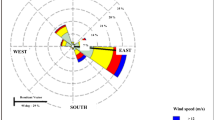Abstract
The objective of wind farm layout optimization (WFLO) is to maximize the power generation with less cost. This paper proposes a program based on genetic algorithm for positioning turbines in a wind farm and studies the effect of wind direction on WFLO. Wind speed is measured at 28 locations in two southern states in India. GIS approach is used to identify the ideal location for a wind farm. Two different scenarios are taken for study; the first is constant wind speed with single direction and the second is constant wind speed with multiple wind directions. A wind farm of 2 km × 2 km is divided into grids of 10 × 10; each grid can have one or no turbine. The wind data of the past three years is taken for the optimization problem. The best solution would accommodate 19 turbines which can generate an average power of 183.55 MW with maximum 343.15 MW in November and a minimum 29.8 MW in May. A case study of wind farm layout optimization along with economical aspect is done in India.
Access this chapter
Tax calculation will be finalised at checkout
Purchases are for personal use only
Similar content being viewed by others
References
K. Anwar, S. Deshmukh, S. Mustafa Rizvi, Feasibility and sensitivity analysis of a hybrid photovoltaic/wind/biogas/fuel-cell/diesel/battery system for off-grid rural electrification using homer. J. Energy Resour. Technol. 142(6), 1–12 (2020)
G. Bekele, G. Tadesse, Feasibility study of small hydro/PV/wind hybrid system for off-grid rural electrification in Ethiopia. Appl. Energy 97, 5–15 (2012)
K. Anwar, S. Deshmukh, Parametric study for the prediction of wind energy potential over the southern part of India using neural network and geographic information system approach. Proc. Inst. Mech. Eng. Part A J. Power Energy 234(1), 96–109 (2020)
M. Abbes, M. Allagui, Centralized control strategy for energy maximization of large array wind turbines. Sustain. Cities Soc. 25, 82–89 (2016)
S.D.O. Turner, D.A. Romero, P.Y. Zhang, C.H. Amon, T.C.Y. Chan, A new mathematical programming approach to optimize wind farm layouts. Renew. Energy 63, 674–680 (2014)
F.G. Montoya, F. Manzano-Agugliaro, S. López-Márquez, Q. Hernández-Escobedo, C. Gil, Wind turbine selection for wind farm layout using multi-objective evolutionary algorithms. Expert Syst. Appl. 41(15), 6585–6595 (2014)
X. Gao, H. Yang, L. Lin, P. Koo, Wind turbine layout optimization using multi-population genetic algorithm and a case study in Hong Kong offshore. J. Wind Eng. Ind. Aerodyn. 139, 89–99 (2015)
L. Parada, C. Herrera, P. Flores, V. Parada, Wind farm layout optimization using a Gaussian-based wake model. Renew. Energy 107, 531–541 (2017)
J.S. González, A.G. Gonzalez Rodriguez, J.C. Mora, J.R. Santos, M.B. Payan, Optimization of wind farm turbines layout using an evolutive algorithm. Renew. Energy 35(8), 1671–1681 (2010)
I. Katic, J. Højstrup, N.O. Jensen, A simple model for cluster efficiency, in EWEC’86. Proceedings, vol. 1 (1987), pp. 407–410
N.O. Jensen, A note on wind generator interaction. Report 87-550-0971-9 (1983)
J.F. Herbert-Acero, O. Probst, P.-E. Réthoré, G.C. Larsen, K.K. Castillo-Villar, A review of methodological approaches for the design and optimization of wind farms. Energies 7(11), 6930–7016 (2014)
H.S. Huang, Distributed genetic algorithm for optimization of wind farm annual profits, in 2007 International Conference on Intelligent Systems Applications to Power Systems, Nov 2007, pp. 1–6
Author information
Authors and Affiliations
Corresponding author
Editor information
Editors and Affiliations
Rights and permissions
Copyright information
© 2021 The Author(s), under exclusive license to Springer Nature Singapore Pte Ltd.
About this paper
Cite this paper
Anwar, K., Deshmukh, S. (2021). Positioning of Wind Turbine in a Wind Farm for Optimum Generation of Power Using Genetic Algorithm for Multiple Direction. In: Reddy, A., Marla, D., Favorskaya, M.N., Satapathy, S.C. (eds) Intelligent Manufacturing and Energy Sustainability. Smart Innovation, Systems and Technologies, vol 213. Springer, Singapore. https://doi.org/10.1007/978-981-33-4443-3_74
Download citation
DOI: https://doi.org/10.1007/978-981-33-4443-3_74
Published:
Publisher Name: Springer, Singapore
Print ISBN: 978-981-33-4442-6
Online ISBN: 978-981-33-4443-3
eBook Packages: EngineeringEngineering (R0)




